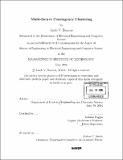| dc.contributor.advisor | Tomaso Poggio. | en_US |
| dc.contributor.author | Bouvrie, Jacob V | en_US |
| dc.contributor.other | Massachusetts Institute of Technology. Dept. of Electrical Engineering and Computer Science. | en_US |
| dc.date.accessioned | 2006-06-19T17:42:56Z | |
| dc.date.available | 2006-06-19T17:42:56Z | |
| dc.date.copyright | 2004 | en_US |
| dc.date.issued | 2004 | en_US |
| dc.identifier.uri | http://hdl.handle.net/1721.1/33122 | |
| dc.description | Thesis (M. Eng.)--Massachusetts Institute of Technology, Dept. of Electrical Engineering and Computer Science, 2004. | en_US |
| dc.description | Includes bibliographical references (p. 93-96). | en_US |
| dc.description.abstract | This thesis examines the problem of clustering multiple, related sets of data simultaneously. Given datasets which are in some way connected (e.g. temporally) but which do not necessarily share label compatibility, we exploit co-occurrence in- formation in the form of normalized multidimensional contingency tables in order to recover robust mappings between data points and clusters for each of the individual data sources. We outline a unifying formalism by which one might approach cross-channel clustering problems, and begin by defining an information-theoretic objective function that is small when the clustering can be expected to be good. We then propose and explore several multi-source algorithms for optimizing this and other relevant objective functions, borrowing ideas from both continuous and discrete optimization methods. More specifically, we adapt gradient-based techniques, simulated annealing, and spectral clustering to the multi-source clustering problem. Finally, we apply the proposed algorithms to a multi-source human identification task, where the overall goal is to cluster grayscale face images according to identity, using additional temporally connected features. It is our hope that the proposed multi-source clustering framework can ultimately shed light on the problem of when and how models might be automatically created to account for, and adapt to, novel individuals as a surveillance/recognition system accumulates sensory experience. | en_US |
| dc.description.statementofresponsibility | by Jacob V. Bouvrie. | en_US |
| dc.format.extent | 96 p. | en_US |
| dc.format.extent | 4795615 bytes | |
| dc.format.extent | 4800564 bytes | |
| dc.format.mimetype | application/pdf | |
| dc.format.mimetype | application/pdf | |
| dc.language.iso | eng | en_US |
| dc.publisher | Massachusetts Institute of Technology | en_US |
| dc.rights | M.I.T. theses are protected by copyright. They may be viewed from this source for any purpose, but reproduction or distribution in any format is prohibited without written permission. See provided URL for inquiries about permission. | en_US |
| dc.rights.uri | http://dspace.mit.edu/handle/1721.1/7582 | |
| dc.subject | Electrical Engineering and Computer Science. | en_US |
| dc.title | Multi-source contingency clustering | en_US |
| dc.type | Thesis | en_US |
| dc.description.degree | M.Eng. | en_US |
| dc.contributor.department | Massachusetts Institute of Technology. Department of Electrical Engineering and Computer Science | |
| dc.identifier.oclc | 62239391 | en_US |
